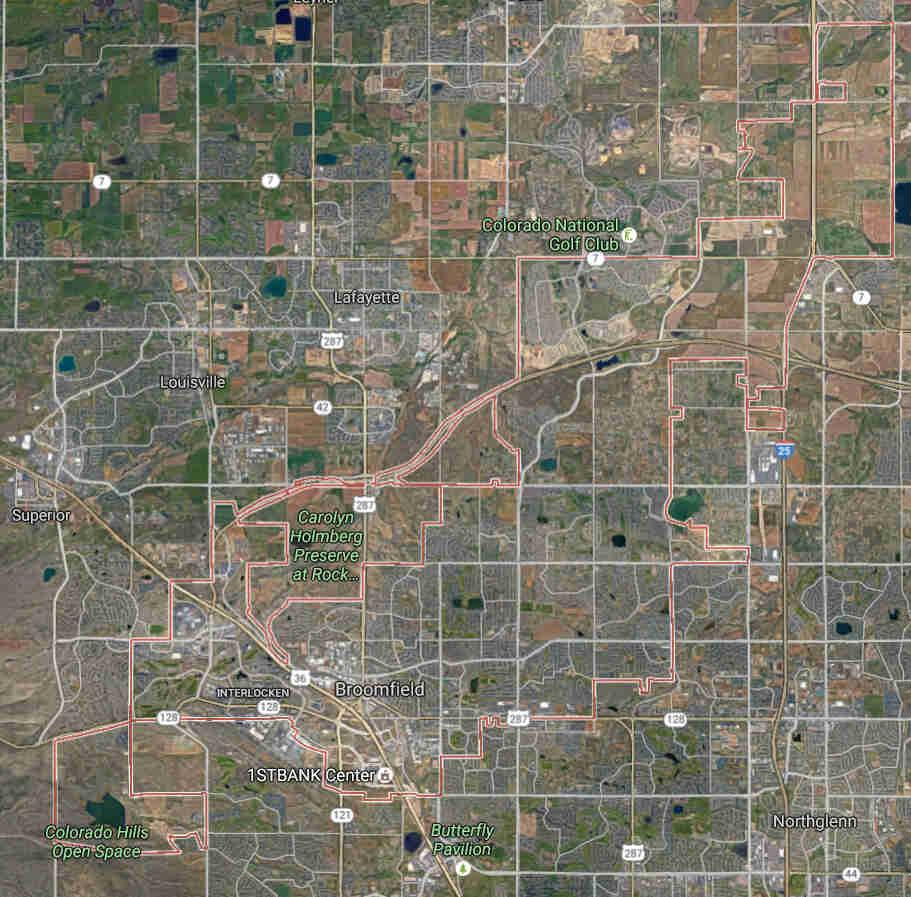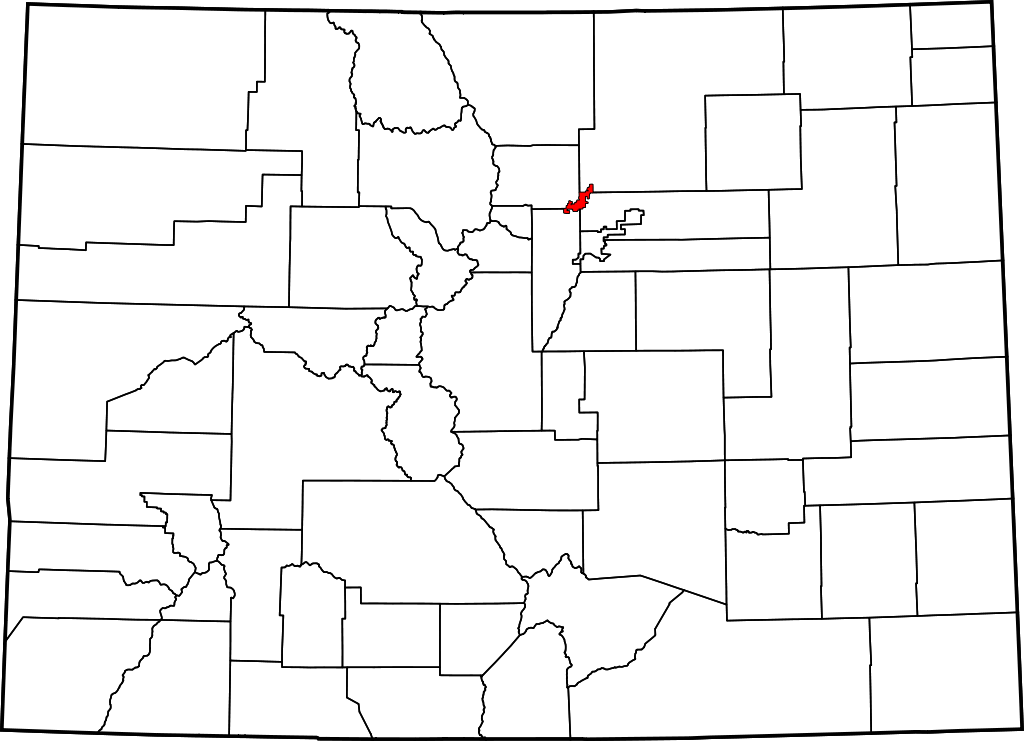City and County of Broomfield
Full Article
The City and County of Broomfield encompasses about thirty-three square miles on the Front Range in central Colorado, mainly between US Highway 36 and Interstate 25 southeast of Boulder. Broomfield supports a population of 65,065 and borders Boulder County to the northwest, Weld County to the northeast, Jefferson County to the southwest, and Adams County to the southeast. Broomfield began as a farming community in the mid-nineteenth century. In 1884 the US Post Office opened a station in the town and named it Broomfield, after broomcorn, a crop that grew well in the area. The city of Broomfield incorporated in 1961 and was part of Boulder County until 2001, when the City and County of Broomfield became Colorado’s sixty-fourth and newest county.
Native Americans
By the early nineteenth century, the Arapaho and Cheyenne people had moved into the area that would become the City and County of Broomfield. Both groups had begun as farmers in the upper Midwest, but conflicts with neighboring groups eventually forced them to the South Platte River Valley. The Cheyenne and Arapaho were nomadic equestrian hunters, crossing the plains in pursuit of bison, their main source of food and trade. They hunted throughout the summer and spent winters in camps along the river and its tributaries, using the cottonwood trees for shelter and fuel.
Trappers, Traders, and Travelers
By the 1820s European and American fur trappers and traders moved onto the plains and scoured the Front Range for bison, beaver, and other furs. To gain access to hides, trappers and traders established trade relationships with indigenous hunters. Rumors of gold in the Rocky Mountains existed, but few white Americans paid attention to them, focusing instead on the California Gold Rush. During the 1840s and 1850s, white travelers and families on their way to California or the Oregon Territory via the Overland Trail crossed Cheyenne and Arapaho territory in Colorado.
In the 1851 Treaty of Fort Laramie, the Cheyenne, Arapaho and other groups of Plains Indians agreed to leave white travelers alone in exchange for control of the land and bison in the Platte River Valley. But the increased traffic of whites had a devastating effect on the Cheyenne and Arapaho’s hunting and wintering grounds. Wagons and teams of oxen trampled large swathes of forage grass, for instance. Whites shot bison and used the precious cottonwood trees along the waterways for fuel and feed. These detrimental activities only increased in the wake of major gold discoveries along the Front Range in 1858–59.
Farming
When the Colorado Gold Rush began in 1858–59, farms sprang up at the feet of the Front Range to feed the mining camps in the mountains. Present-day Broomfield began as one of these agrarian communities, due to its proximity to some of the early mines in Boulder, Clear Creek, and Gilpin Counties. Early white farmers on the arid plains contended with drought, grasshoppers, and Native American raids. To counter the effect of drought, farmers planted crops by waterways or dug irrigation ditches. One crop that proved resistant to area insects was broomcorn, a plant that is similar to corn (maize) but is grown for its stems, which were cut and sewn into brooms.
The Colorado Gold Rush prompted the organization of the Colorado Territory in 1861, and that same year the Treaty of Fort Wise set up a reservation for the Cheyenne and Arapaho in eastern Colorado. The reservation was merely a fraction of the land promised to the two tribes in the earlier Treaty of Fort Laramie. In 1862 the Homestead Act allowed whites in Colorado to quickly and legally obtain the Native American land they had illegally occupied in previous years. Farmers continued to sell crops to both mining towns and travelers along the Cherokee or Overland Trails, both of which ran through Broomfield.
Transportation Hub
Its location along two major trails made Broomfield into an early transportation hub for those traveling between Denver and Boulder, as well as to other places in Colorado and across the country. As mining activity expanded to include gold, silver, and coal, railroads became integral to hauling supplies, ore, and coal to and from mines and cities. The arrival of the Colorado Central Railroad in 1873 largely ended the era of long-distance stagecoach service in Broomfield. Though initially bypassed by the transcontinental Union Pacific Railroad, Denver caught up with its own railroads, and by 1873 the Colorado Central ran through Broomfield on a line from Denver to Cheyenne, Wyoming, where it connected with the Union Pacific.
Around this time the Broomfield stop was referred to as both Section 36 and Broomfield, and this area belonged to Boulder County. In 1881 the Denver, Utah & Pacific Railroad laid narrow gauge rails through what would become Broomfield. In September 1884 the US Post Office opened a station and named it Broomfield. In 1886 the Denver, Marshall & Boulder Railway ran directly through Broomfield, replacing the original route. Additionally, in 1899 the Colorado & Southern Railroad (C&S) ran a narrow gauge line through Broomfield on a route from Denver to Boulder.
In 1904 the C&S incorporated a subsidiary, the Denver and Interurban Railroad (D&I), to provide electric interurban railroad between Denver and Boulder, which began service in 1908. The D&I began operations on June 23, 1908. Known as the Kite Route because of its distinctive shape, the line at one time had twenty-seven possible stops including Westminster, Marshall, Superior, and Louisville. At the present intersection of Wadsworth and 120th Avenues, it built a depot that included living quarters for a stationmaster and his family. The depot served both the C&S and the D&I and also as a community center where Broomfield residents received their news.
“Old” Broomfield
In the 1880s homesteaders began filing claims in the southeastern corner of Boulder County. Two prominent homesteaders included William Brown, an emigrant from England, and Adolph J. Zang, the son of a prominent Denver brewery owner. Zang bought lands owned by the railroads in the present area of 120th and Wadsworth Avenues, along the C&S rail line. This area took on the name Zang’s Spur, after the rail spur that departed from the main route to collect local grain for transport to Zang’s Denver brewery.
Zang’s Elmwood Stock Farm (also known as Zang Ranch) became the most well-known business in early Broomfield. The stock farm also raised Percheron draft horses, which filled the need for draft animals in Colorado that rose with the sugar beet industry. South of Zang’s ranch lay the reservoir that he, August Nissen, and John Huober built in 1887.
By 1900 the farming community in the southeast corner of Boulder County gained notice as a flourishing town with an emerging business district. Early businesses included Robert and Mary Wright’s Broomfield Cheese Factory, which was owned and run primarily by Mary. Henry Naeve became the town’s first blacksmith. Ralph Colman owned the Silver Standard Flour and Feed Mill. “Old” Broomfield ran along 120th Avenue, which also served as the boundary between Boulder and Jefferson Counties.
At the turn of the century Broomfield was divided among three counties. Parts of the city north of 120th Avenue belonged to Boulder County; parts south of 120th belonged to Jefferson County, and parts east of Sheridan Boulevard belonged to Adams County. This affected early residents, businesses, and schools. Children on the north side attended Broomfield school, which was part of Boulder County School District. Those in the south attended Dry Creek School in Jefferson County School District, and children in the east attended Westlake School in Adams County. High school students traveled to Louisville or Lafayette for their education.
Twentieth-Century Development
Broomfield continued to build on its transportation legacy in the twentieth century. In the 1940s, as the age of the automobile progressed, the Colorado Legislature began planning the creation of a turnpike to streamline the commute between Denver and Boulder. This meant building a highway directly through Broomfield. In 1950 ground was broken in Boulder for the new toll road that became the Denver Boulder Turnpike. In January 1952 the Turnpike opened at the Broomfield interchange and was soon lauded as one of the most scenic drives in America.
Following the opening of the turnpike, the Turnpike Land Company bought the old Zang property and announced plans to create a “city by the Turnpike” in 1955. They planned a city to house 20,000 people and become part of the growing Denver Metro area. At the time the city’s population only reached 6,000. The new community was named “Broomfield Heights,” and it catered to the growing middle class of the post–World War II period. The company imagined the community as an alternative to the crowded Denver and Boulder areas, and its homes would be fitted with the newest appliances, including garbage disposals, washers, dryers, and dishwashers. Perhaps more clearly than other developments during the century, Broomfield Heights demonstrated the area’s shift away from its original farming roots and toward its current suburban identity.
As the town and population grew, Broomfield set up temporary cottage schools in buildings that would one day be used as homes. In 1958 Emerald Elementary became the first permanent elementary school in Broomfield Heights, replacing the old one-room schoolhouses and the temporary cottage schools. Kohl Elementary and Broomfield Junior/Senior High School opened in 1959. Empire Savings Building and Loan opened in Broomfield in the 1950s as the first bank to open in the area since the Broomfield State Bank closed during the Great Depression.
Incorporation and Expansion
Broomfield was still a mix of suburban homes and prairie farms when residents began discussing incorporating the city in 1959. They wanted to create their own city government and their own tax base to provide citizens with police, fire, parks and recreation, street maintenance, and other services. The first vote for incorporation failed; the second vote, which excluded Old Broomfield south of 120th Avenue from the city limits, passed, creating the city of Broomfield. The city officially incorporated on June 6, 1961. Throughout its first few decades as a city, Broomfield fought for water rights, increased cultural and commercial development, and expanded into four counties by annexing surrounding areas.
Initially, Broomfield’s water came from the two reservoirs built by Zang on his ranch. However, the Turnpike Land Commission filled in those reservoirs in the 1950s and built a water main from the Great Western Reservoir southwest of Broomfield. Zang’s property held rights on Clear and Coal Creeks, which flowed to the Great Western Reservoir. With Broomfield’s growing population—about 7,200 in 1970—it needed more water than the reservoir provided. In 1971 Broomfield brokered a deal with Denver to buy 11 million gallons of water per day, delivered by a pipeline paid for by the federal government. The Great Western Reservoir remained the city’s main water supply.
In 1963 Broomfield opened a library, named for Mamie Doud Eisenhower, who was raised in Denver, a former first lady, and the woman who donated the Doud Family Collection which comprised most of the books at 12 Garden Center. In 1975 community members formed the Broomfield Historical Society, which focused on saving the historic C&S Depot building and the community history. Like many organizations formed in 1975 and 1976, this one was inspired by the American Bicentennial and the Colorado Centennial. The C&S agreed to sell the building to the historical society and the city if it would move the building to a new site. In 1976 the building moved to W. 10th Avenue, in 1983 the Broomfield Historical Society opened the museum, and in 1988 the name changed to the Broomfield Depot Museum.
In 1969 Broomfield annexed land south into Jefferson County and east of Main Street; it added Greenway Park in 1970, land in Adams County in 1971, and the Westlake Village in 1972. In 1983 and 1986, parts of the Interlocken Business Park joined the city, and the complex became Broomfield’s primary employment center. In 1988 and 1989 the city added land in Weld County to its boundaries. The Flatirons Crossing Mall opened in 2000, further expanding Broomfield’s retail tax base.
Water Quality
In 1973 it was discovered that the nearby Rocky Flats nuclear weapons plant mistakenly allowed some tritium into their wastewater, which eventually contaminated the main reservoir for the city. The EPA deemed the health impact minimal, but in the 1990s another problem from Rocky Flats came to light. Plutonium stored in barrels had contaminated soil at the plant, and that soil washed into the Great Western Reservoir and settled at the bottom. Though the contaminated sediment had been covered, the city chose to take further action to prevent additional contamination. The city now uses Great Western Reservoir as a water source for non-potable water. The city built a new water treatment plant and secured funds for a pipeline to carry water from Carter Lake—a reservoir built as part of the massive Colorado–Big Thompson Project—thus ensuring safe drinking water for residents.
County Formation
With an expanding tax base and a stable water supply, the city of Broomfield began discussing the creation of a separate county in the 1990s. Broomfield had parts in Boulder, Jefferson, Weld, and Adams Counties. The city wanted to create a new county to avoid working with 4 different county authorities, which caused problems for Broomfield residents in working with different county governments for schools, jails, courts, clerks, records, and fire departments. A new county would allow Broomfield residents to ensure that their tax money would be spent on their community. It had the additional benefit of allowing Broomfield citizens a voice in how their city and county would be governed and improved with a combined city and county government.
In a 1998 feasibility study, the city of Broomfield found that it required only a minimal tax increase to become an independent county. That same year, the passage of a statewide ballot initiative added an amendment to the Colorado Constitution that created the City and County of Broomfield as the state’s sixty-fourth county. The new county lines officially took effect on November 15, 2001.
Today
In 2014, with funds from the State Historical Fund and the City and County of Broomfield, the Broomfield Depot Museum building underwent a major rehabilitation. The building’s foundation, windows, trim, doors and siding were repaired, and in 2016 it was listed on the Colorado State Register of Historical Properties. The Broomfield Veterans Memorial Museum, housed at 12 Garden Center—the original location of the Mamie Doud Eisenhower Library—also works to strengthen the community by displaying the history of American military veterans.
Although there are still some twenty-five farms operating in the county, its two largest employers—Level 3 Communications and Oracle—are both technology companies, indicating Broomfield’s transition from frontier farm town to modern, corporate-centric community. As a young county, Broomfield has just begun to write its history, which has already shown that the city and county have a history of taking bold action to ensure residents’ health and prosperity. Like most communities in the Denver metro area, Broomfield continues to experience and grapple with the effects of growth, and its economic, social, and environmental futures will almost certainly be linked with those of the rapidly developing Front Range.















